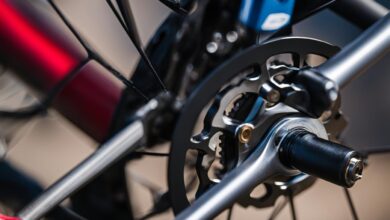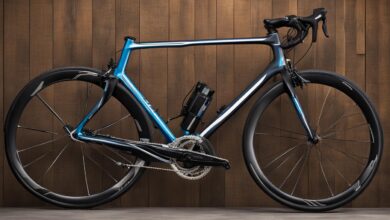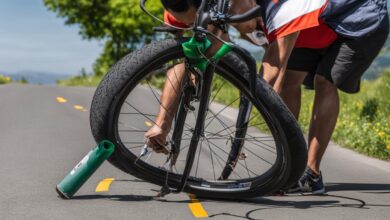Ultimate Road Bike Tire Pressure Guide 2023
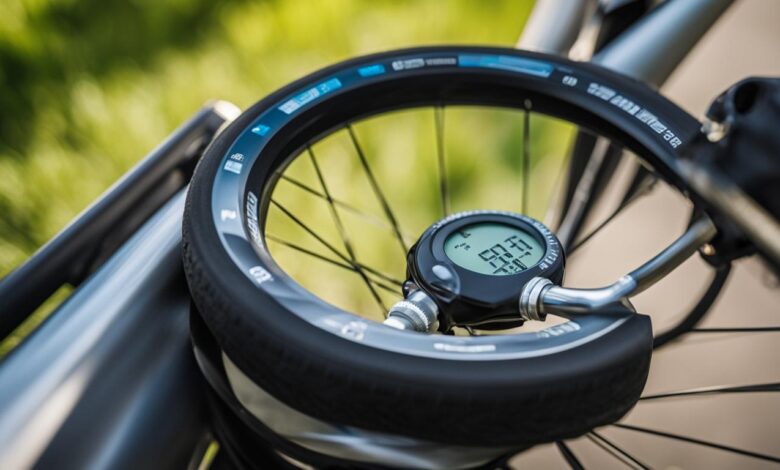
Determining the correct tire pressure for your road bike is essential to optimize performance and efficiency. Factors such as personal preference, bike type, and riding conditions all play a role in determining the right tire pressure for your road bike. By understanding the principles behind tire pressure, you can make informed choices that will enhance your road biking experience.
Key Takeaways:
- Proper tire pressure improves grip, handling, and ride quality.
- Factors to consider when determining tire pressure include weight, tire size, riding conditions, and personal preference.
- Recommended starting tire pressure for different types of road bikes: road bike (90psi), gravel/cyclocross bike (40psi), hybrid bike (50psi), MTB (30psi).
- Tire pressure calculators can provide more precise recommendations based on specific bike and riding conditions.
- Maintaining proper tire pressure ensures safety, performance, longevity, and optimal road bike handling.
Why is Tire Pressure Important for Road Bike Performance?
Tire pressure plays a significant role in the performance of a road bike. Proper tire pressure can improve grip, handling, and overall ride quality. It affects the rolling resistance, traction, and comfort of the bike. Maintaining the optimal tire pressure ensures efficient power transfer, reduces the risk of flats, and enhances the overall riding experience.
When it comes to road bike performance, finding the optimal tire pressure is crucial. The right tire pressure can make a noticeable difference in how the bike performs on the road. It affects various aspects of the ride, including grip, handling, and comfort.
Rolling resistance is one key factor influenced by tire pressure. Rolling resistance refers to the energy required to move the bike forward. Higher tire pressures generally result in lower rolling resistance, allowing the bike to roll more effortlessly and efficiently on smooth surfaces.
Tire pressure also affects traction which is crucial for maintaining control and stability. Proper tire pressure ensures that the tire maintains good contact with the road surface, improving grip and reducing the risk of skidding or sliding.
Comfort is another significant consideration when determining tire pressure. The right tire pressure can provide a more comfortable ride by absorbing shocks and vibrations from the road. It helps to cushion against bumps, reducing the impact on the rider’s body.
To visually illustrate the relationship between tire pressure and road bike performance, refer to the table below:
| Tire Pressure (psi) | Grip | Handling | Ride Comfort |
|---|---|---|---|
| Too Low | Limited | Unstable | Smooth, but risk of flats |
| Optimal | Excellent | Precise | Comfortable |
| Too High | Limited | Harsh | Uncomfortable |
As shown in the table, maintaining proper tire pressure is vital for achieving optimal grip, handling, and ride comfort. It’s important to find the right balance that suits your riding style, weight, and the conditions you often ride in.
Next, we’ll explore the factors to consider when determining the optimal tire pressure for your road bike, including weight, tire size, and riding conditions.
Factors to Consider When Determining Tire Pressure
When determining the ideal tire pressure for your road bike, there are several important factors to take into account. By considering these factors, you can ensure that your tire pressure is optimized for performance, comfort, and safety. Here are the key considerations:
Rider Weight
One of the primary factors influencing tire pressure is rider weight. Heavier riders typically require higher tire pressures to avoid pinch flats and maintain optimal performance. Lighter riders, on the other hand, can benefit from lower tire pressures, which can enhance comfort and traction on the road.
Tire Size
The size of your tires also plays a significant role in determining the recommended tire pressure. Different tire widths have different pressure ranges that ensure optimal support, grip, and rolling resistance. Be sure to consult the manufacturer’s guidelines or a tire pressure chart specific to your tire size.
Riding Conditions
The conditions in which you’ll be riding can impact the ideal tire pressure for your road bike. Smoother surfaces may require higher pressures to reduce rolling resistance and maximize speed. On the other hand, rough or uneven terrain may call for lower pressures to enhance comfort and maintain better traction.
Personal Preference
Personal preference is another important factor to consider when determining tire pressure. Some riders prefer a firmer feel with higher pressures, while others prefer a softer ride with lower pressures. Experimenting with different pressures can help you find the balance that provides the performance and comfort you desire.
By taking into account factors such as rider weight, tire size, riding conditions, and personal preference, you can determine the recommended tire pressure for your road bike. Finding the right balance will ensure optimal support, traction, and comfort for your specific riding needs.
| Rider Weight | Tire Size | Riding Conditions | Personal Preference |
|---|---|---|---|
| Heavier riders may require higher tire pressures to prevent pinch flats. | The size of your tires influences the recommended pressure range. | Smoother surfaces may benefit from higher pressures, while rough terrain requires lower pressures. | Personal preference plays a role in determining tire pressure. |
| Lighter riders can benefit from lower tire pressures for improved comfort. | Consult the manufacturer’s guidelines or a pressure chart specific to your tire size. | Adjust tire pressure based on the road conditions you’ll be encountering. | Experiment to find the pressure that provides the desired performance and comfort. |
Recommended Tire Pressure for Different Types of Road Bikes
Maintaining proper tire pressure is essential for road bike performance. The recommended tire pressure may vary depending on factors such as tire width, rider weight, and road conditions. Here are some approximate starting points for different types of road bikes:
| Road Bike | Gravel/Cyclocross Bike | Hybrid Bike | MTB |
|---|---|---|---|
| 90psi / 6.2 bar | 40psi / 2.8 bar | 50psi / 3.4 bar | 30psi / 2.1 bar |
These figures serve as starting points and can be adjusted based on your specific preferences and conditions. It’s important to find the right tire pressure that offers a balance of traction, comfort, and performance for your road biking experience.
“Inflate your tires to the recommended pressure before each ride – better yet, every day.” – Cycling Weekly
Using a Tire Pressure Calculator
If you want a more precise tire pressure figure based on your specific bike and riding conditions, tire pressure calculators can be incredibly useful tools. These calculators take into account factors such as tire width, weight, and desired ride quality to provide recommended tire pressure ranges. Tools like the SRAM tire pressure calculator are designed to help riders find the optimal tire pressure based on their unique requirements.
By inputting key details such as tire width, rider weight, and road surface conditions into a tire pressure calculator, you can obtain customized recommendations that ensure optimal performance and safety. These calculators consider the interplay between various factors to provide a reliable starting point for your tire pressure adjustment.
For instance, the SRAM tire pressure calculator uses a sophisticated algorithm to analyze your inputs and generate recommended tire pressures tailored to your specific road bike. The calculator takes into account factors such as tire type, rider weight distribution, road conditions, and desired ride quality to provide accurate and personalized recommendations.
Using a tire pressure calculator not only saves you time and guesswork but also helps you fine-tune your tire pressure for the best possible riding experience. Whether you’re a competitive cyclist or a recreational rider, the tire pressure calculator ensures that your road bike is optimized for performance and comfort.
How to Use the SRAM Tire Pressure Calculator
The SRAM tire pressure calculator is a user-friendly tool for determining the recommended tire pressures for your road bike. Follow these simple steps to utilize this calculator:
- Visit the SRAM website or access the calculator through their mobile app.
- Select your tire width from the provided options or input the exact measurement in millimeters.
- Enter your rider weight, including any additional gear or equipment you typically carry while riding.
- Choose your preferred ride quality based on options such as comfort or performance.
- Indicate the road conditions you typically encounter, such as smooth pavement, rough roads, or mixed terrain.
- Click the “Calculate” button.
- The SRAM tire pressure calculator will generate a recommended tire pressure range specifically tailored to your road bike and riding preferences.
Remember, these recommendations are a starting point, and you can fine-tune your tire pressure based on personal preference and further experimentation. Regularly check and adjust your tire pressure to ensure optimal performance and safety on the road.
Utilizing a tire pressure calculator like the SRAM tool simplifies the process of determining the optimal tire pressure for your road bike. By taking into account key factors such as tire width, rider weight, and desired ride quality, these calculators provide valuable guidance for achieving the perfect balance between performance, comfort, and safety.
Understanding the Relationship Between Tire Pressure and Bike Handling
Tire pressure plays a crucial role in the handling of your road bike. Maintaining proper tire pressure is vital for optimizing your bike’s performance, ensuring optimal traction, cornering stability, and comfort.
Insufficient tire pressure can make your bike feel sluggish and unresponsive. It can compromise your ability to maneuver effectively, impacting your overall riding experience. On the other hand, excessive tire pressure can lead to a harsh and uncomfortable ride, reducing your control over the bike.
To find the right balance, it’s essential to regularly check and maintain proper tire pressure. This involves inflating your road bike tires to the recommended pressure levels specified by the tire manufacturer. By doing so, you’ll ensure optimal grip, responsiveness, and overall handling.
Here are some tips for inflating your road bike tires:
- Use a reliable tire pressure gauge: Invest in a quality pressure gauge to accurately measure the tire pressure. Avoid relying solely on the pressure gauge present on the pump, as they can be less precise.
- Familiarize yourself with the recommended tire pressure range: Consult the tire manufacturer’s guidelines or the sidewall of the tire for the recommended pressure range.
- Inflate gradually and check pressure frequently: Inflate the tires gradually, stopping periodically to check the pressure with the gauge. This ensures you avoid overinflation.
- Consider rider weight and riding conditions: Adjust the tire pressure based on your weight and the type of riding conditions you typically encounter. Heavier riders may require slightly higher pressure for optimal support, while lighter riders may prefer slightly lower pressure for improved comfort.
- Be mindful of temperature changes: Tire pressure can vary with temperature, so it’s essential to check and adjust the pressure accordingly if you’re riding in significantly different weather conditions.
By following these tips and maintaining the proper tire pressure, you can optimize your road bike’s handling, ensuring a smooth, controlled, and enjoyable riding experience.
“Maintaining the optimal tire pressure ensures efficient power transfer, reduces the risk of flats, and enhances the overall riding experience.” – Pro Cyclist
Tire Pressure and the Impact on Rolling Resistance
Tire pressure plays a crucial role in determining the rolling resistance of a road bike. Rolling resistance refers to the energy required to propel the bike forward. By understanding how tire pressure affects rolling resistance, you can optimize your riding experience for speed and efficiency.
Higher tire pressures tend to reduce rolling resistance, allowing for a faster ride on smooth surfaces. When the tire is inflated to a higher pressure, it creates less contact area with the road, reducing friction and making it easier for the bike to roll forward. This translates into increased speed and improved efficiency, ideal for those seeking high-performance rides.
However, it is essential to strike a balance with tire pressure. Excessively high pressures can lead to decreased comfort, control, and traction, especially on rougher or uneven terrains. Riding with excessively high pressures can result in a harsh and uncomfortable ride, compromising your ability to handle the bike effectively.
To find the optimal tire pressure for your road bike, consult a road bike tire pressure chart. This chart provides a recommended tire pressure range based on your tire width and riding conditions. By selecting the appropriate tire pressure within this range, you can achieve the ideal balance between rolling resistance, comfort, control, and traction.
Using the chart as a reference, you can determine the optimal tire pressure for your specific road bike setup. By inflating your tires within the recommended range, you can maximize speed, efficiency, and overall ride quality.
Tire Pressure and Road Surface Conditions
The road surface conditions can significantly impact the performance and ride quality of your road bike. When determining the recommended tire pressure for road bikes, it’s crucial to consider the type of terrain you’ll be riding on. Different road surface conditions require adjustments in tire pressure to ensure optimal performance, safety, and comfort.
For smooth and well-paved roads, higher tire pressures are generally recommended. These higher pressures reduce rolling resistance, allowing for faster and more efficient rides. The increased tire pressure helps minimize the contact area between the tire and the road, reducing friction and improving speed.
However, when riding on rough or bumpy roads, a lower tire pressure is advised. Lower pressures offer improved traction and better shock absorption, enhancing comfort and stability. By reducing tire pressure, the tires can better conform to the road surface, providing more grip and reducing the impact of bumps and vibrations.
Adjusting tire pressure based on road surface conditions is crucial for maintaining control and achieving optimal ride quality. It’s important to find the right balance between grip, comfort, and efficiency to ensure an enjoyable and safe ride.
Expert Tip: Check your tire pressure regularly
To ensure your road bike tires are properly inflated for different road surface conditions, it’s important to check your tire pressure regularly. Use a reliable pressure gauge to measure the pressure and compare it with the recommended range for your specific tire type and riding conditions.
| Road Surface Conditions | Recommended Tire Pressure |
|---|---|
| Smooth and well-paved roads | 85-95 psi / 5.9-6.5 bar |
| Rough or bumpy roads | 70-80 psi / 4.8-5.5 bar |
Remember to adjust the tire pressure within the recommended range based on your personal preferences and riding style. By maintaining the optimal tire pressure for different road surface conditions, you can maximize performance, comfort, and safety during your road biking adventures.
The Importance of Proper Tire Pressure for Safety
Maintaining proper tire pressure is crucial for ensuring a safe and enjoyable cycling experience on the road. Improperly inflated tires, whether overinflated or underinflated, can have significant consequences that compromise your control, grip, and overall safety.
When your tire pressure is too high, your road bike becomes less responsive and harder to handle. Overinflated tires have reduced contact with the road surface, leading to decreased traction and compromised control while cornering or braking. This can increase the risk of accidents and decrease your ability to react quickly in unexpected situations.
Conversely, if your tire pressure is too low, it can result in a spongy and sluggish ride. Underinflated tires increase the rolling resistance, making it harder to maintain speed and efficiency. Additionally, low pressure makes your bike more susceptible to flats and punctures due to increased friction and a higher risk of pinch flats.
To ensure your safety on the road, it’s essential to regularly check your tire pressure using a pressure gauge. Refer to the manufacturer’s recommendations or consult a tire pressure chart to determine the optimal range for your road bike tires. By inflating your tires to the recommended level, you can achieve the right balance between comfort, performance, and safety.
Tips for Inflating Road Bike Tires
1. Use a reliable pressure gauge: Invest in a quality pressure gauge that allows you to accurately measure the tire pressure. Avoid relying on visual estimates or using outdated gauges that may not provide accurate readings.
2. Check pressure before every ride: Make it a habit to check your tire pressure before each ride, as air naturally escapes over time. This ensures that your tires are properly inflated and ready for optimal performance.
3. Inflate to the recommended range: Follow the manufacturer’s recommendations for tire pressure, which are often indicated on the side of the tire. Aim to inflate your tires within the recommended range to achieve the best balance of grip, control, and comfort.
4. Consider riding conditions: Adjust your tire pressure based on the riding conditions you anticipate. For smoother surfaces, slightly higher tire pressure may enhance speed and efficiency. On rough or uneven terrain, slightly lower tire pressure can improve comfort and traction.
“Maintaining proper tire pressure is essential for safety and overall performance. Remember to regularly check and inflate your tires to the recommended level for a safe and enjoyable ride.”
Taking the time to maintain proper tire pressure for your road bike is a small but significant step towards ensuring your safety on the road. By following these tips and regularly monitoring your tire pressure, you can optimize your road bike’s performance, control, and grip. Don’t compromise on safety, and always prioritize a properly inflated tire for a confident and secure ride.
Factors Affecting Tire Pressure Longevity
Tire pressure plays a significant role in the longevity of your road bike tires. Maintaining proper tire pressure not only ensures optimal performance but also helps extend the lifespan of your tires. Incorrect tire pressure can lead to excessive wear, increased risk of pinch flats, and accelerated tread wear. It’s essential to find the right balance and maintain adequate tire pressure for a safe and enjoyable riding experience.
Riding with underinflated tires can cause excessive wear on the sidewalls, making them more susceptible to damage and premature failure. Additionally, underinflated tires increase the risk of pinch flats, where the tire is compressed between the rim and an obstacle, resulting in a puncture.
On the other hand, overinflating your tires can lead to a harsher ride and accelerated tread wear. Overinflated tires have reduced contact with the road surface, affecting traction and compromising safety. It can also contribute to uneven tread wear, reducing the overall lifespan of the tire.
To maintain proper tire pressure for your road bike, regularly check and adjust the pressure according to the manufacturer’s recommendations. Use a reliable pressure gauge to ensure accuracy. By maintaining the optimal tire pressure, you can maximize the longevity of your tires, reduce the risk of flats, and enjoy consistent performance throughout your rides.
Benefits of Wide Tires and Lower Tire Pressure
The trend towards wider tires and lower tire pressures has gained popularity in recent years. Riders have discovered several benefits associated with this setup, enhancing their road biking experience.
1. Increased Comfort
Wide tires offer a larger contact surface with the road, resulting in improved shock absorption. This translates to a smoother ride, reducing fatigue and allowing for longer rides without discomfort.
2. Improved Traction
Wide tires provide enhanced grip, especially on challenging terrains or wet surfaces. The increased traction offers riders greater confidence, enabling them to tackle corners and descents with increased stability and control.
3. Enhanced Stability
Lower tire pressures in combination with wider tires contribute to a more stable ride. The larger tire volume increases stability, particularly when navigating varying road conditions or when encountering bumps and cracks.
4. Better Shock Absorption
Lower tire pressures allow for improved shock absorption, minimizing the impact of imperfections on the road surface. This results in a more comfortable ride, reducing the strain on the rider’s body.
Overall, the combination of wider tires and lower tire pressures can greatly enhance the road biking experience by providing increased comfort, improved traction, enhanced stability, and better shock absorption. Consider experimenting with this setup to fully enjoy the benefits it offers.
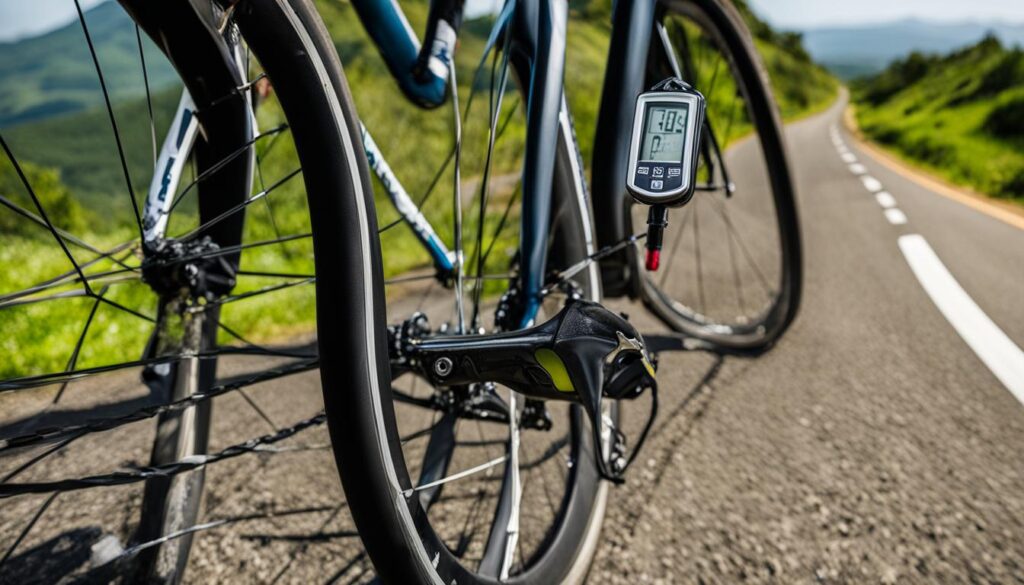
Conclusion
Proper tire pressure is crucial for optimizing the performance of your road bike. By carefully considering factors such as rider weight, tire size, riding conditions, and personal preference, you can determine the ideal tire pressure that suits your specific needs. Regularly checking and maintaining tire pressure is essential to ensure safety, enhance performance, and prolong the lifespan of your tires.
Experimenting with wider tires and lower pressures can bring numerous benefits to your road cycling experience. Wide tires offer increased comfort and stability, while lower tire pressures allow for better shock absorption and improved traction on rough surfaces. By finding the right balance between tire width and pressure, you can enjoy a smoother ride and reduced rolling resistance.
Refer to this comprehensive Road Bike Tire Pressure Guide to unlock the full potential of your road cycling adventures. Remember, maintaining proper tire pressure is not only crucial for performance but also for safety. Invest time and effort into understanding and adjusting your tire pressure, and you’ll reap the rewards of a more enjoyable, efficient, and safe ride.
FAQ
Why is tire pressure important for road bike performance?
Tire pressure is crucial for optimal road bike performance as it affects grip, handling, rolling resistance, and overall ride quality. Maintaining the proper tire pressure ensures efficient power transfer, reduces flats, and enhances the riding experience.
What factors should I consider when determining tire pressure for my road bike?
When determining tire pressure, factors such as rider weight, tire size, riding conditions, and personal preference should be taken into account. Heavier riders may require higher pressures, while lighter riders can benefit from lower pressures. The type of tire and road conditions also influence the optimal tire pressure.
What is the recommended tire pressure for different types of road bikes?
The recommended tire pressure varies depending on the type of road bike. As a starting point, a road bike typically requires 90psi / 6.2 bar, a gravel/cyclocross bike requires 40psi / 2.8 bar, a hybrid bike requires 50psi / 3.4 bar, and an MTB requires 30psi / 2.1 bar. These values may vary based on tire width, rider weight, and road conditions.
How can I use a tire pressure calculator to determine the optimal tire pressure for my road bike?
Tire pressure calculators take into account factors such as tire width, weight, and desired ride quality to provide recommended tire pressure ranges. Tools like the SRAM tire pressure calculator can help riders find the optimal tire pressure based on their specific requirements.
How does tire pressure affect bike handling?
Proper tire pressure is essential for optimal bike handling. Insufficient pressure can make the bike feel sluggish and unresponsive, while excessive pressure can lead to a harsh and uncomfortable ride. Finding the right balance provides optimal traction, cornering stability, and comfort.
How does tire pressure impact rolling resistance?
Tire pressure affects rolling resistance, which is the measure of energy required to roll the bike forward. Higher pressures reduce rolling resistance, resulting in a faster ride on smooth surfaces. However, excessively high pressures can decrease comfort, control, and traction.
How does tire pressure affect road surface conditions?
Road surface conditions influence the optimal tire pressure. While smooth surfaces benefit from higher pressures for reduced rolling resistance, rough or bumpy roads require lower pressures to improve comfort and traction. Adjusting tire pressure based on road surface conditions ensures optimal performance and ride quality.
What is the importance of maintaining proper tire pressure for safety?
Maintaining proper tire pressure is crucial for safety on the road. Overinflated or underinflated tires can result in decreased control, reduced grip, and an increased risk of flats. Regularly checking and maintaining tire pressure is essential for a safe and enjoyable ride.
How does tire pressure affect tire longevity?
Riding with underinflated tires can cause excessive wear on the sidewalls and increase the risk of pinch flats. Overinflated tires may result in a harsher ride and accelerated tread wear. Maintaining proper tire pressure extends the lifespan of tires and ensures optimal performance.
What are the benefits of using wider tires and lower tire pressure?
Wider tires offer increased comfort, improved traction, and enhanced stability. Lower tire pressures provide better shock absorption, reduced rolling resistance on rough surfaces, and a smoother overall ride. Experimenting with wider tires and lower pressures can enhance the comfort and overall ride quality of a road bike.
How can I determine the ideal tire pressure for my road bike?
By considering factors such as rider weight, tire size, riding conditions, and personal preference, you can determine the ideal tire pressure for your road bike. Regularly checking and maintaining tire pressure ensures safety, performance, and longevity.
